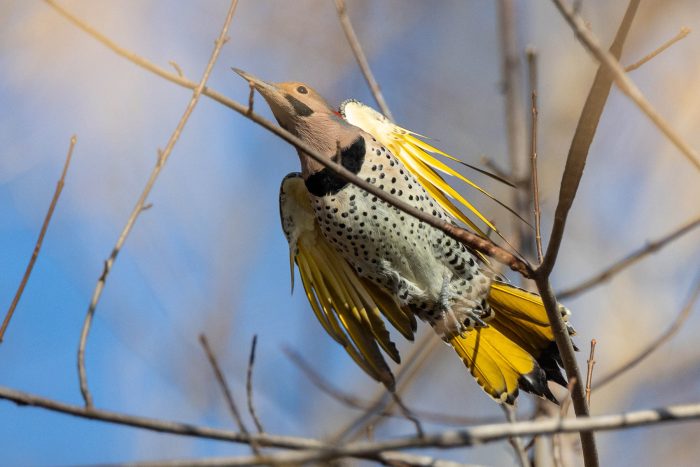Northern Flicker
Colaptes auratus
The northern flicker is a ground-feeding woodpecker with eye-catching patterns.
This section shows one large critter image at a time. Use the thumbnails that follow to select a specific image to display here.

This gallery contains a grid of small thumbnails. Selecting a thumbnail will change the main image in the preceding section.
Appearance
The northern flicker has two subspecies, the red-shafted and yellow-shafted. The red-shafted flickers reside in the western United States and have red color on the underside of their wings and tail. The yellow-shafted flicker resides in the eastern United States and has a yellow color on the underside of their wings and tail. Red-shafted flickers have a brown face and grey head and males have a red mark below their beak known as a “mustache stripe.” Yellow-shafted flickers have a grey face with a brown head and males have a black mustache and a red mark on the back of their heads. Both are brown with spotted chests, mottled wings and a black crescent on their chest.
Feeding
Flickers spend most of the year foraging for bugs in the ground. Ants are their favorite food and can be up to 50% of their diet.
Predators
Young birds are preyed upon by raccoons, snakes and raptors. Adult birds are also preyed upon by raptors.
Flight
Flickers have a similar flight pattern as other woodpeckers which consists of several flaps and a dive. When they are flying viewers can see the bright colors on the underside of their wings and tail.
Voice
Flickers make a repetitive shrill call several times for about six to seven seconds. They also use drumming on wood as a form of communication. Woodpeckers use drumming like songbirds use singing.
Reproduction and life cycle
To attract mates and to defend their nest males will make dramatic courtship displays moving their head back and forth and showing the bright color on the underside of their wings. Males and females will excavate a nest in deadwood and a new nest is created each year. The female will lay 5-8 eggs. In about two weeks the eggs will hatch and they will leave the nest in four weeks. Flickers in northern states will raise one brood per year and flickers in southern states will raise two broods per year.
Did you know?
- Northern flickers have adapted to suburban and urban settings. In search of dead wood for a nesting cavity, they will sometimes create nests in telephone poles.
- When drumming, woodpeckers generally search for the object that makes the most noise so they will sometimes find metal poles, signs or roofing material to drum on.
Sources and additional information
- Northern Flicker - U.S. Geological Survey
- Northern Flicker - Audubon
- Northern Flicker - Celebrate Urban Birds
